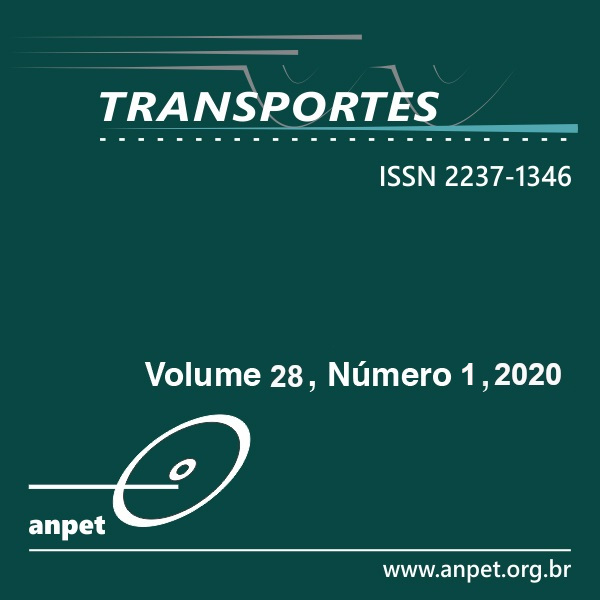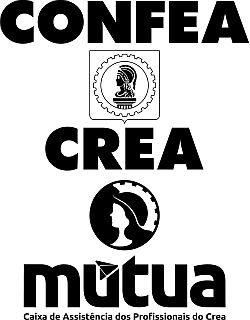Airport pavement roughness evaluation based on cockpit and center of gravity vertical accelerations
DOI:
https://doi.org/10.14295/transportes.v28i1.1932Keywords:
Airport pavements, Pavement roughness, Vertical accelerations, International roughness index, Boeing bump index.Abstract
Rough pavements are generally responsible for vertical accelerations (VA) that can affect the aircraft, increase stopping distance and difficult to read the cockpit instrumentation. The International Roughness Index (IRI) and the Boeing Bump Index (BBI) are currently used to quantify airport pavement roughness and to identify sections that require maintenance and rehabilitation (M&R) activities. However, these indices were developed only based on dynamic responses of an automobile at 80 km/h to the irregularities of road pavements, and on physical characteristics of the irregularities (bump length and height), respectively, without considering the effect of aircraft VA. Additionally, current critical limits, suggested by Sayers & Karamihas and ANAC, for IRI (2.0 and 2.5 m/km, respectively) and by FAA for BBI (1.0) can misjudge the real condition of the pavement. This paper evaluates the effect of airport pavement roughness on VA at the aircraft cockpit (VACP) and at the center of gravity (VACG). The ProFAA software was used to compute both indices and to simulate VA in 4 representative aircraft traversing 20 runway profiles at 10 operational speeds varying from 37 to 370 km/h. Statistical comparisons and regression analyses were carried out. Principal results show that VACP is 50% higher than VACG and that exceeds the critical limit of 0.40 g when the IRI and BBI are higher than 3.7 m/km and 0.20, correspondingly. A case study is also presented to compare these limits and shows that decision-making based on IRI and VA can bring significant differences in the number of M&R activities.
Downloads
References
ASTM. (2018). Standard Practice for Computing International Roughness Index of Roads from Longitudinal Profile Meas-urements. ASTM E1926 - 08. American Society of Testing and Materials. USA. DOI: 10.1520/E1926-08R15.
ACRP. (2011). Common Airport Pavement Maintenance Practices. A Synthesis of Airport Practice. ACRP Synthesis No. 22. Air-port Cooperative Research Program. Transportation Research Board. USA. ISBN 978-0-309-14334-9
Alford, W. (1972). Functional requirements of airport pavements, an airline pilots viewpoint. Second Annual Short Course in Structural Design of Airport Pavements. University of Illinois. Urbana, Illinois, USA.
ANAC. (2019). Aeródromos - Operação, Manutenção e Resposta à Emergência. RBAC No. 153. Emenda No.04. Agência Nacional de Aviação Civil. Brasil.
ANAC. (2012). Aeródromos - Operação, Manutenção e Resposta à Emergência. RBAC No. 153. Emenda No.00. Agência Nacional de Aviação Civil. Brasil.
Boeing. (2002). Runway Roughness Measurement, Quantification, and Application - The Boeing Method. Document No. D6-81746. Boeing Commercial Airplane Group. Airport Technology Organization (B-B210). Seattle, Washington, USA.
FAA. (2018). Federal Aviation Administration. Retrieved September 29, 2018, from Airport Pavement Roughness Research: http://www.airporttech.tc.faa.gov/Airport-Pavement/Nondestructive-Pavement-Testing/AirportPavementRoughnessResearch.
FAA. (2013). Airport Pavement 10-Year R&D Program. Aviation Research Division. Airport Technology R&D Branch. Federal Aviation Administration Technical Center. Atlantic City, New Jersey, USA.
FAA. (2009). Guidelines and Procedures for Measuring Airfield Pavement Roughness. Advisory Circular No. 150/5380-9. U.S. Department of Transportation. Federal Aviation Administration. USA.
Ferritto, J. M., & Forrest, J. B. (1976). Effects of Pavement Roughness on Naval Air Operations. Technical Report TR-846. Naval Facilities Engineering Command. Civil Engineering Laboratory. Naval Construction Battalion Center, CA. Alexandria, VA, USA.
Gerardi, A. G. (1997). The effect of runway roughness on aircraft operations. Aircraft/Pavement Technology In the Midst of Change. Seattle, Washington, USA. ISBN: 0784402868.
Gillespie, T. D. (1992). Everything You Always Wanted to Know about the IRI, But Were Afraid to Ask! Road Profile Users Group Meeting. Lincoln, Nebraska, USA.
Haas, R., Hudson, W. R., & Falls, L. C. (2015). Pavement Asset Management. USA & Canada: Scrivener Publishing WILLEY. ISBN 978-1-119-03870-2
Horn, W. J. (1977). Airfield Pavement Smoothness Requirements. Technical Report S-77-12. Soils and Pavements Laboratory. U.S. Army Engineer Wterways Experiment Station, Vicksburg, Miss. Washington, D.C., USA.
Houbolt, J. C. (1961). Runway roughness studies in the aeronautical field. ASCE Proceedings. Journal of Air Transport Division, 87(AT 1), 11-31. USA.
Kirk, C. L. (1973). Analysis of Taxiing Induced Vibrations in Aircraft by The Power Spectral Density Method. Cranfield Report Aero No. 15. Structural and Aerospace Dynamics Group, College of Aeronautics. Cranfield Institute of Technology. England.
Morris, G. J., & Hall, A. W. (1965a). Recent Studies of Runway Roughness. Conference on Aircraft Operating Problems: A Compila-tion of the Papers Presented. Langley Research Center. National Aeronautics and Space Administration, pp. 1-7.
Morris, G. J., & Hall, A. W. (1965b). Response of a WB-47E Airplane to Runway Roughness at Eielson Air Force Base. Technical Memorandum SX-1076. Langley Research Center. Langley Station, Hampton, VA. National Aeronautics and Space Administration. Washington, D.C., USA.
NASA. (1992). Issues on Human Acceleration Tolerance After Long-Duration Space Flights. NASA-TM-104753. National Aeronautics and Space Administration. Lyndon B. Johnson Space Center, 55. Houston, Texas, USA.
Sayers, M. W., & Karamihas, S. M. (1998). The Little Book of Profiling. Basic Information About Measuring and Interpreting Road Profiles. USA: University of Michigan.
Sayers, M. W., & Karamihas, S. M. (1996). Interpretation of Road Roughness Profile Data. Final Report FHWA-RD-96-10. The University of Michigan Transportation Research Institute. Federal Highway Administration. McLean, VA, USA.
Sayers, M. W., Gillespie, T. D., & Patterson, W. D. (1986). Guidelines for Conducting and Calibrating Road Roughness Measurements. WORLD BANK TECHNICAL PAPER NUMBER 46. Washington, D.C., USA.
Sayers, M., Gillespie, T. D., & Queiroz, C. (1986). The International Road Roughness Experiment - Establishing Correlation and a Calibration Standard for Measurements. WORLD BANK TECHNICAL PAPER NUMBER 45. Washington, D.C., USA.
Sayers, M., Gillespie, T. D., & Queiroz, C. (1984a). International Experiment to Establish Correlation and Standard Calibration Methods for Road Roughness Measurements. UMTRI-84-12-1. The University of Michigan, Transportation Research Institute and Brazil Road Research Institute. The World Bank and Brazil Ministry of Transportation. Brazil.
Sayers, M., Gillespie, T. D., & Queiroz, C. (1984b). International Experiment to Establish Correlation and Standard Calibration Methods for Road Roughness Measurements - APPENDICES. UMTRI-84-12-2. The University of Michigan, Transportation Research Institute and Brazil Road Research Institute. The World Bank and Brazil Ministry of Transportation. Brazil.
Spangler, E. B., & Gerardi, A. G. (1993). Measurement and Analysis of Airside Pavement Roughness at the Dallas/Fort Worth International Airport. Airport Pavement Innovations. Theory to Practice. Proceedings of Conference, pp. 329-346. Vicksburg, Mississippi, USA.
Downloads
Published
How to Cite
Issue
Section
License
Authors who submit papers for publication by TRANSPORTES agree to the following terms:
- The authors retain the copyright and grant Transportes the right of first publication of the manuscript, without any financial charge, and waive any other remuneration for its publication by ANPET.
- Upon publication by Transportes, the manuscript is automatically licensed under the Creative Commons License CC BY 4.0 license. This license permits the work to be shared with proper attribution to the authors and its original publication in this journal.
- Authors are authorized to enter into additional separate contracts for the non-exclusive distribution of the version of the manuscript published in this journal (e.g., publishing in an institutional repository or as a book chapter), with recognition of the initial publication in this journal, provided that such a contract does not imply an endorsement of the content of the manuscript or the new medium by ANPET.
- Authors are permitted and encouraged to publish and distribute their work online (e.g., in institutional repositories or on their personal websites) after the editorial process is complete. As Transportes provides open access to all published issues, authors are encouraged to use links to the DOI of their article in these cases.
- Authors guarantee that they have obtained the necessary authorization from their employers for the transfer of rights under this agreement, if these employers hold any copyright over the manuscript. Additionally, authors assume all responsibility for any copyright infringements by these employers, releasing ANPET and Transportes from any responsibility in this regard.
- Authors assume full responsibility for the content of the manuscript, including the necessary and appropriate authorizations for the disclosure of collected data and obtained results, releasing ANPET and Transportes from any responsibility in this regard.









